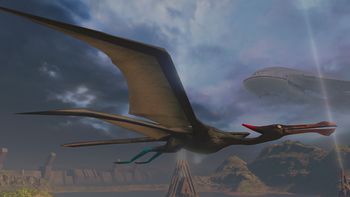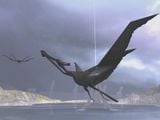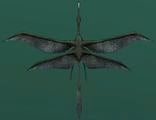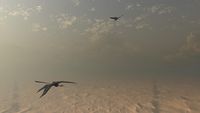Rangmejo
From Halopedia, the Halo wiki
Rangmejo are flying creatures that inhabit the artificial ecosystems of a number of Forerunner constructs, namely Installation 03,[1] Installation 05,[2] and Installation 00.[3] They are occasionally hostile, especially in large numbers.[1] Though they have been encountered numerous times by the United Nations Space Command, only a handful of specimens have ever been procured for scientific study.
Anatomy and physiology
Human scientists have discovered remarkable evidence of genetic optimization. Quadwings are large pterosaur-like creatures with two sets of impressive wings flanking a narrow, muscular body. A quadwing's head features a strong, lengthy beak and a protruding crest–often brightly colored. Quadwings have long tails that can represent over half of the animal's body itself.
Despite being of presumably alien nature, these creatures bore a surprising similarity to pterosaurs, which were an order of reptiles that lived on Earth within the Mesozoic. Their double set of wings and long, rigid tail gave them a striking resemblance to Earth's dragonflies as well.
History
Rangmejo were among the creatures preserved by the Librarian against the firing of the Halo Array in 97,445 BCE.[4][5] Following this destructive event they were seeded upon at least two Halo rings, installations 03 and 05, while also being left to flourish on the Ark, Installation 00, far beyond the Milky Way galaxy. Rangmejo had been specifically selected and adapted by Lifeworkers to play diverse and important roles within a wide range of ecosystems, helping to contribute to the overall health and stability of various biomes.[6]
In November of 2552 rangmejo were observed by the battling forces of the Covenant and United Nations Space Command when their war brought them to Installation 05.[7] Following the discovery and subsequent exploration of Installation 03 by humanity in 2552 and 2553, they were witnessed there as well.[8] Respected scientist Doctor Luther Mann's observations of the rangmejo on Gamma Halo made him certain it would not be safe to get close to them.[8] Template:Expand-Section
Trivia

|
Browse more images in this article's gallery page. |
- Quadwings appear in the Halo 2 campaign levels Delta Halo and Regret. In Halo 3, they can be found in the multiplayer levels Guardian and Epitaph.
- Players can shoot these creatures or stick them with Spike Grenades or Plasma Grenades on several Campaign and Multiplayer levels. If shot, they will burst and fall to bloody tatters in mid-air, their gory ribbons tend to just "poof" in the air with few visible body parts falling. Upon death, the quadwing's body disappears for a fraction of a second, then reappears larger than before.
- The birds seen in High Charity in the Halo 2 level Gravemind are sometimes mistaken for quadwings, but upon closer examination, one can see that they are a different species.
- In Halo Mash-Up: Minecraft Evolved, the Ender Dragon boss mob is retextured to look like a quadwing.
- In response to the increase in questions relating to the quadwing's origins, Frank O'Connor claimed that "They are basically space pigeons, or flying rats. All they do is breed, poop and fly slowly around. Their only known skill is the ability to predict human marksmen and turn just exactly as you were about to shoot them." on an April Fools edition of Halo Waypoint's Canon Fodder blog.[9]
Gallery
List of appearances
- Halo 2 (First appearance)
- Halo 3
- Halo 2: Anniversary
- Halo: Hunters in the Dark
- Halo: Outpost Discovery
Sources
- ^ a b Halo: Hunters in the Dark, page 242 (Google Play edition)
- ^ Halo 2, campaign levels, Delta Halo and Regret
- ^ Halo 3, multiplayer maps Guardian and Epitaph
- ^ Halo Waypoint: Cannon Fodder - Array With Words
- ^ Halo Waypoint - Librarian
- ^ Halo Waypoint: Cannon Fodder - Jurassic Ark
- ^ Halo 2, Delta Halo
- ^ a b Halo: Hunters in the Dark, Chapter 15
- ^ Halo Waypoint: Canon Fauxder - Believe








